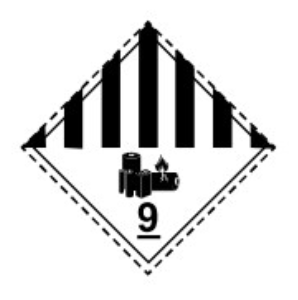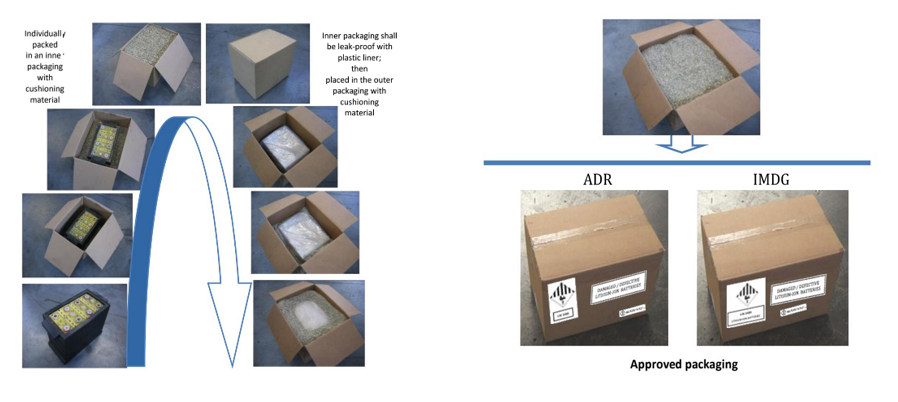Transport P908 LP904
CELLS AND BATTERIES DAMAGED & DEFECTIVE – Not Critical
Non liable to dangerously react during transport
Applies to:
Lithium ion and lithium metal cells and batteries, damaged or defective, including those contained in equipment
UN No., Proper
Shipping Nam
UN 3090, LITHIUM METAL BATTERIES or UN 3091, LITHIUM METAL BATTERIES CONTAINED IN EQUIPMENT
UN 3480, LITHIUM ION BATTERIES or UN 3481, LITHIUM ION BATTERIES CONTAINED IN EQUIPMENT
Class
9

Packing Group
n/a
Hazard Label
• Labels must be in the form of a square set at an angle of 45° (diamond-shaped) with minimum dimensions of 100
mm by 100 mm; except for air transport mode, labels dimensions may be reduced in the case of packages of such
dimensions that they can only bear smaller labels.
• They must have a line 5 mm inside the edge and running parallel with it.

Prerequisite
• Cells and batteries liable to rapidly disassemble, dangerously react, produce a flame or a dangerous
evolution of heat or a dangerous emission of toxic, corrosive or flammable gases or vapours under normal
conditions of carriage, shall be carried according P911 and LP906 (see § 2.4.2) or under conditions
specified by the competent authority.
Transport mode
ADR
IMDG
IATA Forbidden
Cells and batteries
identified by the
manufacturer as
being defective for
safety reasons,
or that have been
damaged, that have
the potential of
producing a
dangerous evolution
of heat, fire or short
circuit are
forbidden for
transport
(e.g. those being
returned to the
manufacturer for
safety reasons);
Special
Provisions
376
376
Lithium ion cells or batteries and lithium metal cells or batteries identified as being damaged or defective such that they
do not conform to the type tested according to the applicable provisions of the Manual of Tests and Criteria shall comply
with the requirements of this special provision.
For the purposes of this special provision, these may include, but are not limited to:
– Cells or batteries identified as being defective for safety reasons;
– Cells or batteries that have leaked or vented;
– Cells or batteries that cannot be diagnosed prior to carriage; or
– Cells or batteries that have sustained physical or mechanical damage.
NOTE: In assessing a cell or battery as damaged or defective, an assessment or evaluation shall be performed based on safety
criteria from the cell, battery or product manufacturer or by a technical expert with knowledge of the cell’s or battery’s sa fety
features. An assessment or evaluation may include, but is not limited to, the following criteria:
(a) Acute hazard, such as gas, fire, or electrolyte leaking;
(b) The use or misuse of the cell or battery;
(c) Signs of physical damage, such as deformation to cell or battery casing, or colours on the casing;
(d) External and internal short circuit protection, such as voltage or isolation measures;
(e) The condition of the cell or battery safety features; or
(f) Damage to any internal safety components, such as the battery management system.”
Cells and batteries shall be packed in accordance with packing instructions P908 or LP904, as applicable
Packing
instructions
P908
P908
Use only approved packaging conforming to Packing Group II performance level:
• Drums (1A2, 1B2, 1N2, 1H2, 1D, 1G);
• Boxes (4A, 4B, 4N, 4C1, 4C2, 4D, 4F, 4G, 4H1, 4H2)
• Jerricans (3A2, 3B2, 3H2)
A cell or battery with a net mass of more than 30 kg shall be limited to one cell or battery per outer packaging.
LP904
LP904
Large packagings are authorized for a single damaged or defective battery and for a single item of equipment.
Use only approved large packaging conforming to Packing Group II performance level, made of:
• steel (50A) • rigid plastics (50H)
• aluminium (50B) • plywood (50D)
• metal other than steel or aluminium (50N)
Packing
requirements
Each damaged or defective battery or equipment containing such a battery shall be individually packed in an inner packaging
and placed inside an outer packaging. The inner packaging or outer packaging shall be leak- proof to prevent the potential
release of electrolyte.
Each inner packaging shall be surrounded by sufficient non-combustible and non-conductive thermal insulation material to
protect against a dangerous evolution of heat.
Sealed packagings shall be fitted with a venting device when appropriate.
Appropriate measures shall be taken to minimize the effects of vibrations and shocks, prevent movement of the battery
within the package that may lead to further damage and a dangerous condition during carriage. Cushioning material that is
non-combustible and non-conductive may also be used to meet this requirement.
Non combustibility shall be assessed according to a standard recognized in the country where the packaging is designed or
manufactured.
For leaking batteries, sufficient inert absorbent material shall be added to the inner or outer packaging to absorb any release
of electrolyte.
Batteries shall be protected against short circuit.
Weight limit
No limit
No limit
Tunnel code
(E)
–
Transport category
2
–
Exemptions
limite max 333Kg Net
–
Marking and
Labelling of
Packages
UN3090 or UN3091 or UN3480 or UN3481
UN 3090 LITHIUM METAL BATTERIES or UN 3091 LITHIUM METAL BATTERIES CONTAINED IN EQUIPMENT or UN 3480 LITHIUM ION BATTERIES OR UN 3481 LITHIUM ION BATTERIES CONTAINED IN EQUIPMENT


Damage/Defective Lithium-Ion Batteries or Damage/Defective Lithium Metal Batteries
DAMAGED/DEFECTIVE LITHIUM-ION BATTERIES OR DAMAGED/DEFECTIVE LITHIUMMETAL BATTERIES
Overpack
OVERPACK + same labels as above
OVERPACK + same labels as above
Documents
Transport document
The transport document shall include the following
statement “Transport in accordance with special
provision 376”.
MDGF
The transport document shall include the following statement
“Transport in accordance with special provision 376”.
Practical example of packaging, marking and labelling of packages containing cells and batteries Damaged or Defective

| CELLS AND BATTERIES DAMAGED & DEFECTIVE – Not Critical Non liable to dangerously react during transport |
||||||
|---|---|---|---|---|---|---|
| Applies to: | Lithium ion and lithium metal cells and batteries, damaged or defective, including those contained in equipment | |||||
| UN No., Proper Shipping Nam |
UN 3090, LITHIUM METAL BATTERIES or UN 3091, LITHIUM METAL BATTERIES CONTAINED IN EQUIPMENT UN 3480, LITHIUM ION BATTERIES or UN 3481, LITHIUM ION BATTERIES CONTAINED IN EQUIPMENT |
|||||
| Class | 9 |
|
||||
| Packing Group | n/a | |||||
| Hazard Label | • Labels must be in the form of a square set at an angle of 45° (diamond-shaped) with minimum dimensions of 100 mm by 100 mm; except for air transport mode, labels dimensions may be reduced in the case of packages of such dimensions that they can only bear smaller labels. • They must have a line 5 mm inside the edge and running parallel with it. |
 |
||||
| Prerequisite | • Cells and batteries liable to rapidly disassemble, dangerously react, produce a flame or a dangerous evolution of heat or a dangerous emission of toxic, corrosive or flammable gases or vapours under normal conditions of carriage, shall be carried according P911 and LP906 (see § 2.4.2) or under conditions specified by the competent authority. |
|||||
| Transport mode | ADR | IMDG | IATA Forbidden Cells and batteries identified by the manufacturer as being defective for safety reasons, or that have been damaged, that have the potential of producing a dangerous evolution of heat, fire or short circuit are forbidden for transport (e.g. those being returned to the manufacturer for safety reasons); |
|||
| Special Provisions |
376 | 376 | ||||
| Lithium ion cells or batteries and lithium metal cells or batteries identified as being damaged or defective such that they do not conform to the type tested according to the applicable provisions of the Manual of Tests and Criteria shall comply with the requirements of this special provision. For the purposes of this special provision, these may include, but are not limited to: – Cells or batteries identified as being defective for safety reasons; – Cells or batteries that have leaked or vented; – Cells or batteries that cannot be diagnosed prior to carriage; or – Cells or batteries that have sustained physical or mechanical damage. NOTE: In assessing a cell or battery as damaged or defective, an assessment or evaluation shall be performed based on safety criteria from the cell, battery or product manufacturer or by a technical expert with knowledge of the cell’s or battery’s sa fety features. An assessment or evaluation may include, but is not limited to, the following criteria: (a) Acute hazard, such as gas, fire, or electrolyte leaking; (b) The use or misuse of the cell or battery; (c) Signs of physical damage, such as deformation to cell or battery casing, or colours on the casing; (d) External and internal short circuit protection, such as voltage or isolation measures; (e) The condition of the cell or battery safety features; or (f) Damage to any internal safety components, such as the battery management system.” Cells and batteries shall be packed in accordance with packing instructions P908 or LP904, as applicable |
||||||
| Packing instructions |
P908 | P908 | ||||
| Use only approved packaging conforming to Packing Group II performance level: • Drums (1A2, 1B2, 1N2, 1H2, 1D, 1G); • Boxes (4A, 4B, 4N, 4C1, 4C2, 4D, 4F, 4G, 4H1, 4H2) • Jerricans (3A2, 3B2, 3H2) A cell or battery with a net mass of more than 30 kg shall be limited to one cell or battery per outer packaging. |
||||||
| LP904 | LP904 | |||||
| Large packagings are authorized for a single damaged or defective battery and for a single item of equipment. Use only approved large packaging conforming to Packing Group II performance level, made of: • steel (50A) • rigid plastics (50H) • aluminium (50B) • plywood (50D) • metal other than steel or aluminium (50N) |
||||||
| Packing requirements |
Each damaged or defective battery or equipment containing such a battery shall be individually packed in an inner packaging and placed inside an outer packaging. The inner packaging or outer packaging shall be leak- proof to prevent the potential release of electrolyte. Each inner packaging shall be surrounded by sufficient non-combustible and non-conductive thermal insulation material to protect against a dangerous evolution of heat. Sealed packagings shall be fitted with a venting device when appropriate. Appropriate measures shall be taken to minimize the effects of vibrations and shocks, prevent movement of the battery within the package that may lead to further damage and a dangerous condition during carriage. Cushioning material that is non-combustible and non-conductive may also be used to meet this requirement. Non combustibility shall be assessed according to a standard recognized in the country where the packaging is designed or manufactured. For leaking batteries, sufficient inert absorbent material shall be added to the inner or outer packaging to absorb any release of electrolyte. Batteries shall be protected against short circuit. |
|||||
| Weight limit | No limit | No limit | ||||
| Tunnel code | (E) | – | ||||
| Transport category | 2 | – | ||||
| Exemptions | limite max 333Kg Net | – | ||||
| Marking and Labelling of Packages |
UN3090 or UN3091 or UN3480 or UN3481 | UN 3090 LITHIUM METAL BATTERIES or UN 3091 LITHIUM METAL BATTERIES CONTAINED IN EQUIPMENT or UN 3480 LITHIUM ION BATTERIES OR UN 3481 LITHIUM ION BATTERIES CONTAINED IN EQUIPMENT | ||||
 |
 |
|||||
| Damage/Defective Lithium-Ion Batteries or Damage/Defective Lithium Metal Batteries | DAMAGED/DEFECTIVE LITHIUM-ION BATTERIES OR DAMAGED/DEFECTIVE LITHIUMMETAL BATTERIES | |||||
| Overpack | OVERPACK + same labels as above | OVERPACK + same labels as above | ||||
| Documents | Transport document The transport document shall include the following statement “Transport in accordance with special provision 376”. |
MDGF The transport document shall include the following statement “Transport in accordance with special provision 376”. |
||||
| Practical example of packaging, marking and labelling of packages containing cells and batteries Damaged or Defective | ||||||
 |
||||||

